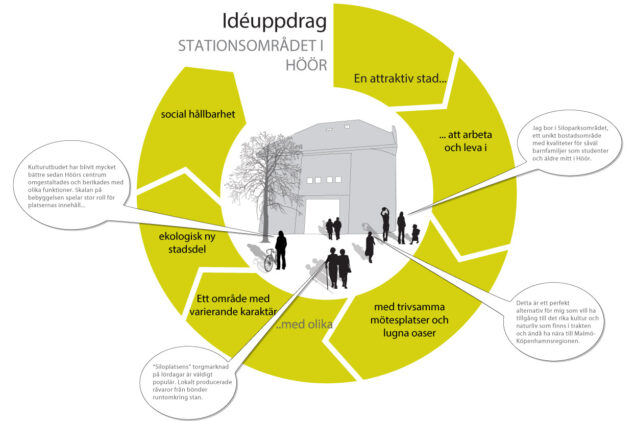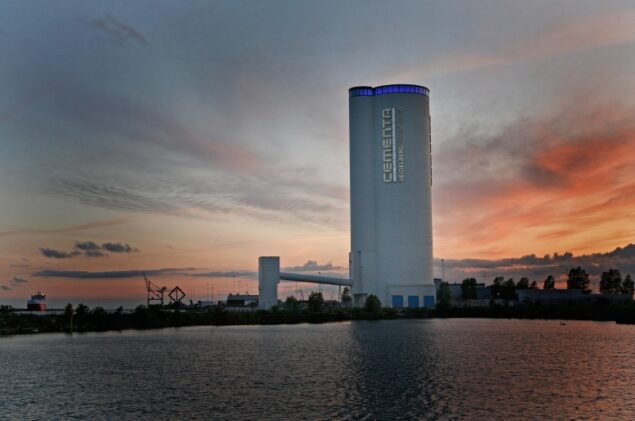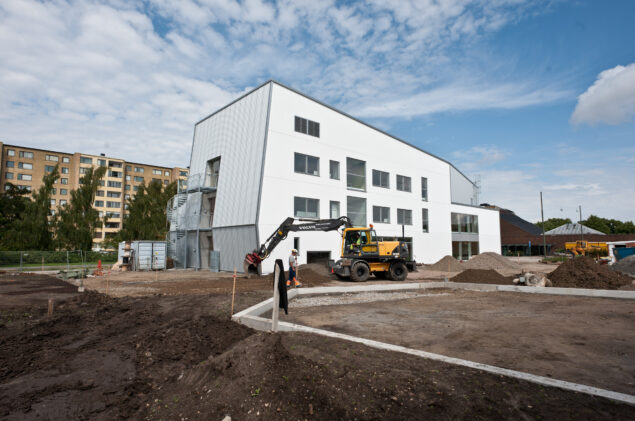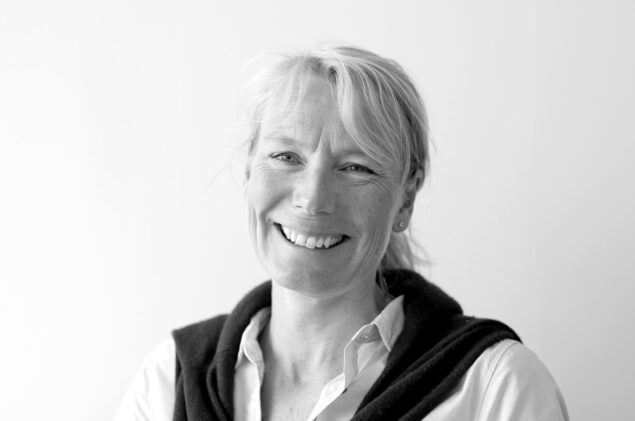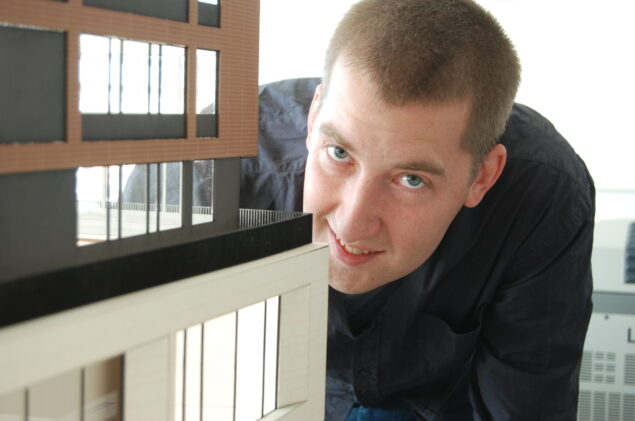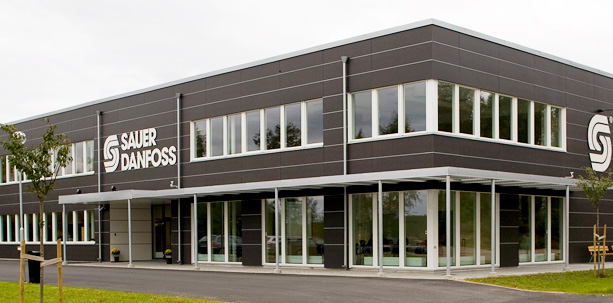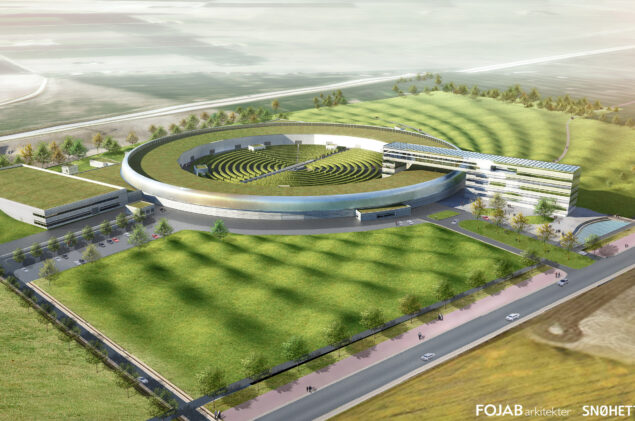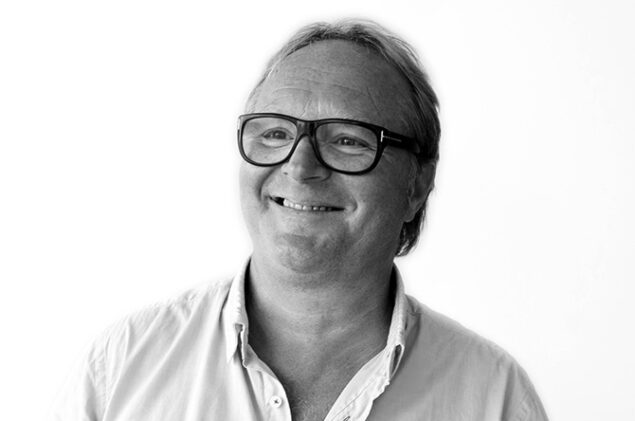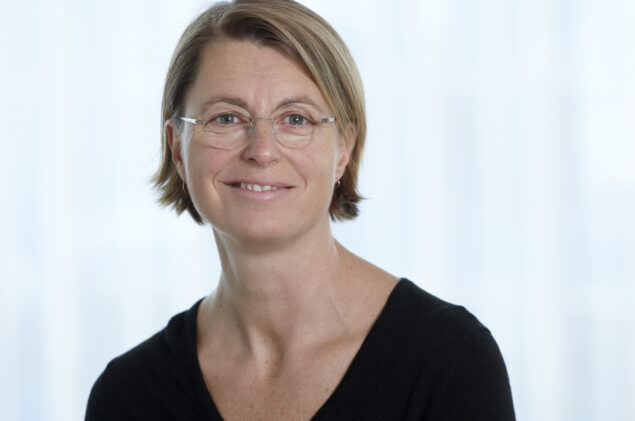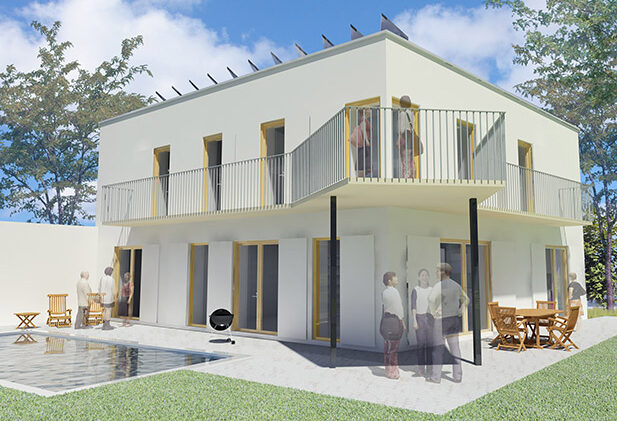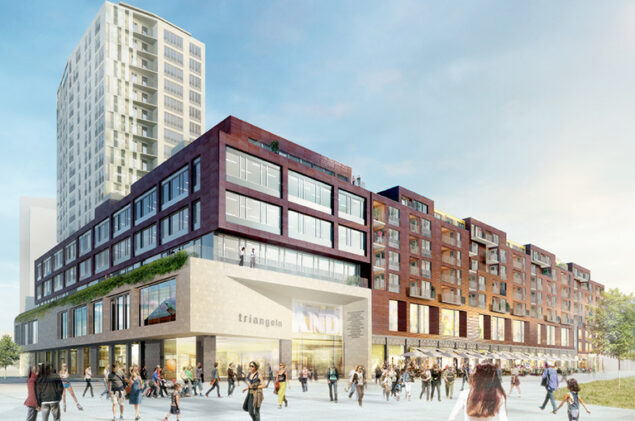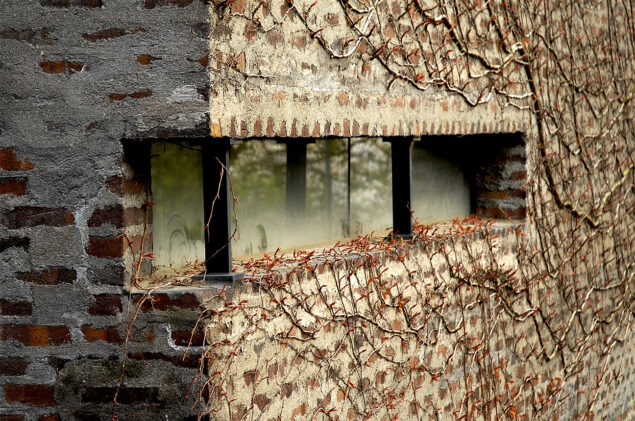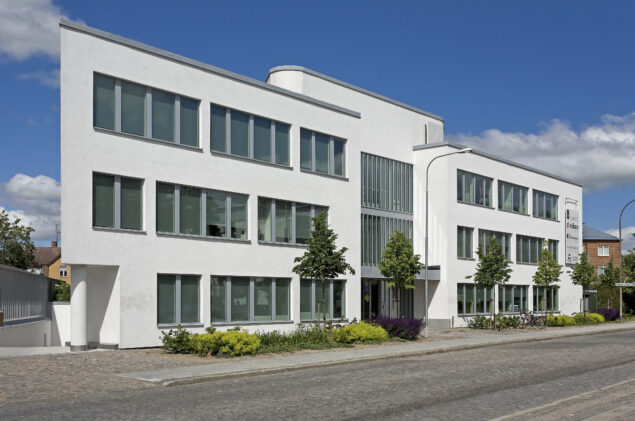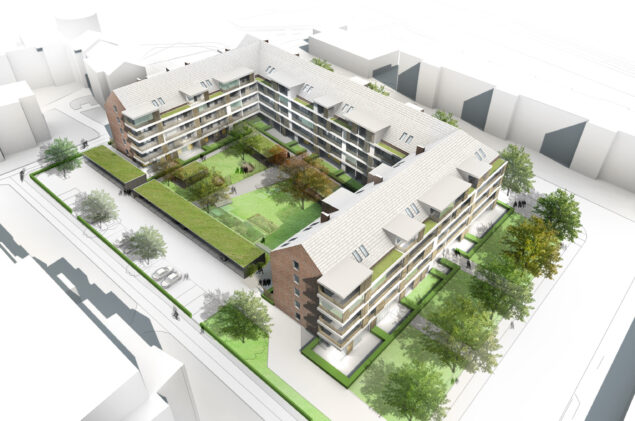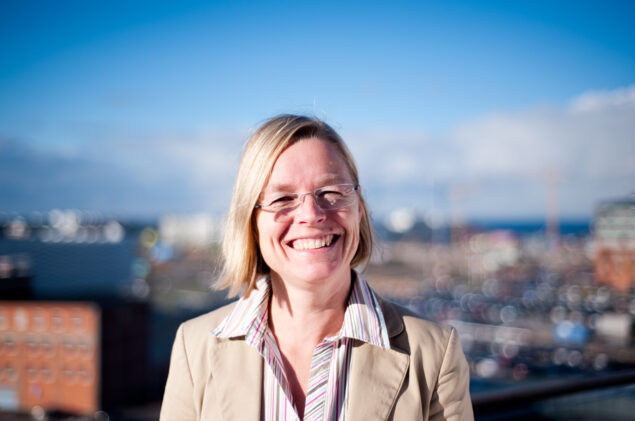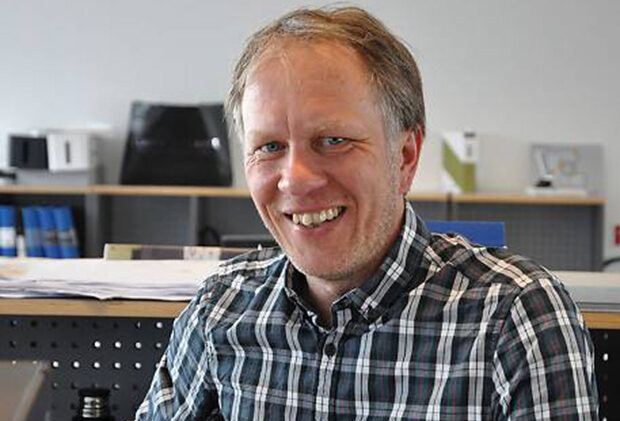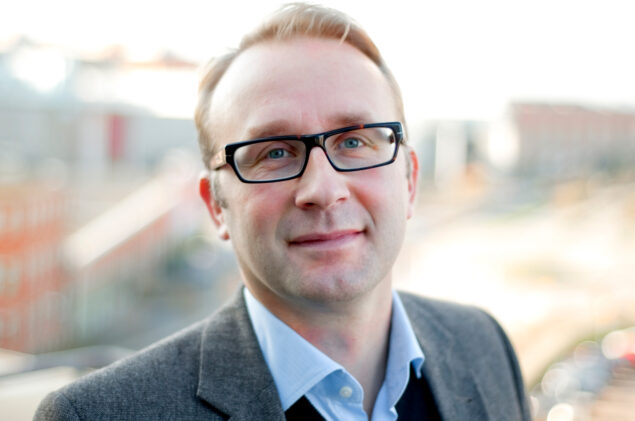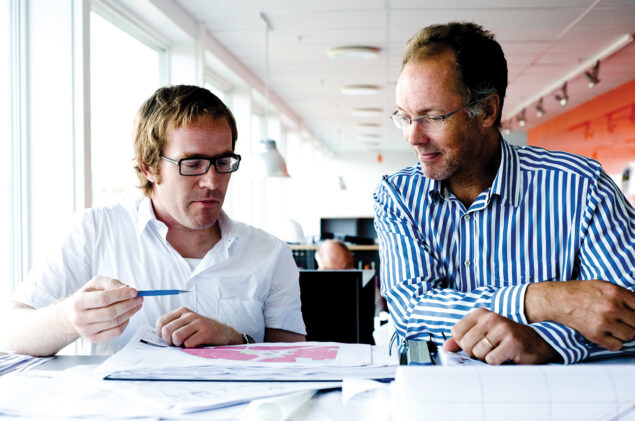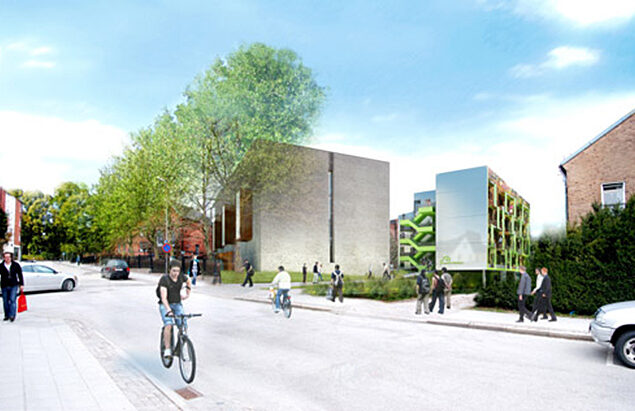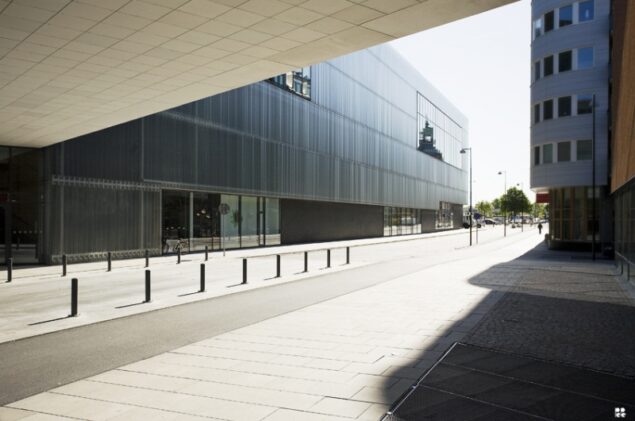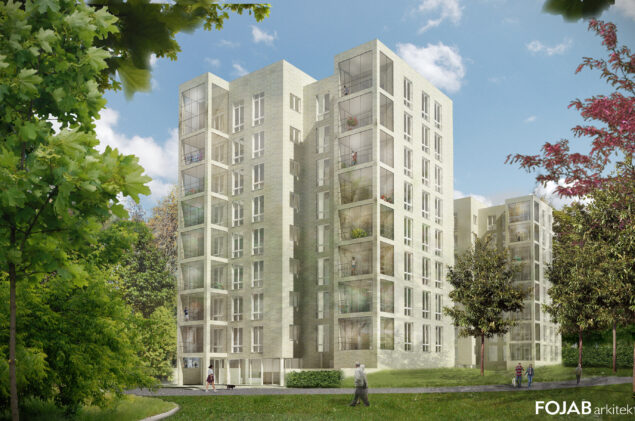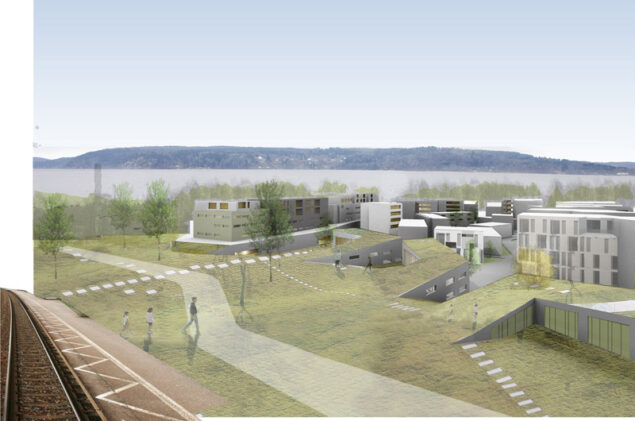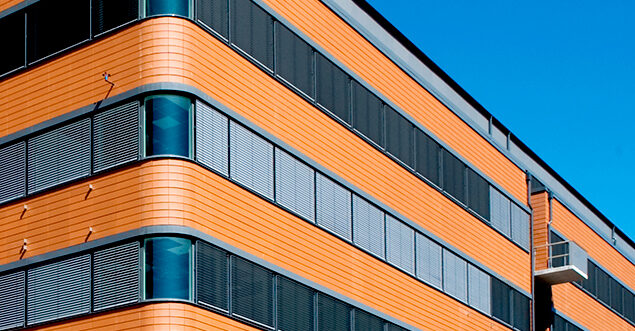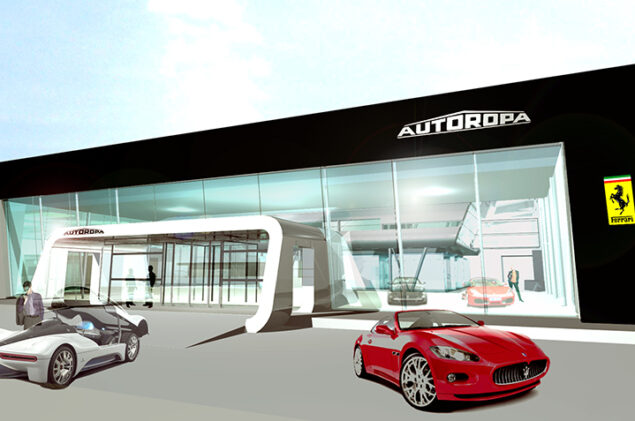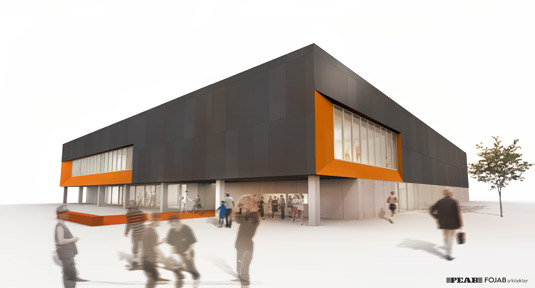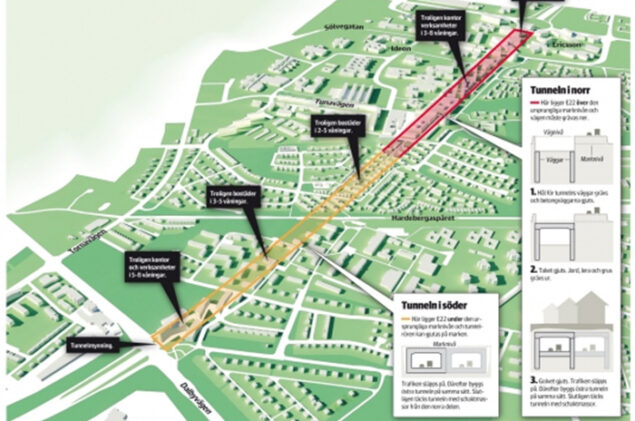2012-04-19
Höör's new station area
FOJAB has been selected as one of four offices to produce an idea sketch for the station area in Höör.
The assignment covers an area with businesses, west of Höörs station, which will be transformed into an attractive, sustainable and vibrant residential area with elements of historical buildings. The results of the parallel assignment will be presented on FOJAB's website later this spring.
The firm was selected in competition with 40-50 architectural firms. The jury justified its choice by saying that the firm has good experience of similar projects that "show new thinking where the site and the surrounding conditions are taken advantage of and with good design given a new identity".
2012-03-20
Malmö's new super silo is inaugurated
On March 15, Cementa's new silo in Malmö's northern harbor was inaugurated by Ilmar Reepalu, Chairman of the City Council.
FOJAB has designed the new super silo which, with its diameter of 26 m and height of 93 m, is the second tallest building in Malmö and one of the largest cement silo facilities in Europe. As Cementa leaves its site in Limhamn, it makes room for new housing, and the people of Limhamn are spared heavy transportation through the community.
- The slip-formed cement tank has been linked to the surface-mounted transportation tower to create a coherent and shimmering white sculptural form. At the top is a lookout room that glows an intense blue at night, turning the silo into a lighthouse that can be seen from afar," says architect Greger Dahlström.
2012-01-27
We are designing environmentally friendly rental apartments in Hyllie.
On December 2, Ilmar Reepalu, Chairman of the City Council, Lars Svensson, Chairman of MKB and Sonny Modig, CEO of MKB, broke ground on the 89 rental apartments that MKB will build in Hyllie along the main street Hyllie Boulevard. The block is a stone's throw from the City Tunnel and the closest neighbors are Emporia and Malmö Arena.
The building is constructed at an angle with seven and ten floors, with three commercial premises on the ground floor and a lush courtyard with a communal barbecue area on the second floor.
The apartments maintain a very high interior standard in terms of choice of materials. The apartments have one or two balconies or a patio and all apartments have a large bathroom with a washing column. The facade of the building will consist of board material in varying shades and structures with different expressions towards Hyllie Boulevard and Hyllie Vattenparksgata.
The building will be environmentally classified according to Miljöbyggnad, which means a particularly strong focus in the areas of energy, indoor environment and materials. In the project, MKB will also work with solar energy, biodiversity and green space factor. Occupancy will take place in stages from the fourth quarter of 2013.
2011-11-25
Housing in Linköping
FOJAB arkitekter has been commissioned by HSB Östergötland to design a new residential quarter with 50 apartments at Folkets Park in Linköping.
The block in question is a challenge mainly because of its location on the edge of the area, right next to a noisy thoroughfare to the west. To the east, there is a part of the park that is almost like a forest hill, and it is against this lushness that the block opens up its interior.
The elevated courtyard is intended to be characterized by playfulness, greenery and water features. Via a staircase and a wide opening in the ground floor of the building, it connects with the local street that leads further south into the residential area. The water mirrors are an important element of the courtyard design as they reflect light and forest greenery into the homes. Together with the terraces, they become the link between the courtyard and the forest.
Folkets Park, which was inaugurated in 1921, is centrally located in Linköping and is characterized by a lush park environment. A small, central part of the park will be retained and renovated for its original purpose and the rest will be developed with five-storey apartment buildings and a small terraced house area - a total of about 300 new homes.
2011-10-26
St. Mary's School inaugurated
Mariaskolan, an independent school with students in grades F-9, will open its new premises designed by FOJAB architects in the fall of 2011.
- "It is wonderful and almost unreal that we have now reached our goal," says Ann-Christin Berglund, principal of Mariaskolan, which is ready to be used by 250 expectant students and staff.
- It is so clearly the start of something new. We already notice that we see each other and meet in a completely different way than before. The premises create opportunities and help us to develop the school's content, pedagogically and methodologically. They invite new ways of working - to explore and renew our activities.
With a 20-year-old temporary building permit and a single-storey section building nearing the end of its technical life, the situation became urgent to address. A working group was set up to investigate the premises issue from a broad perspective. Everything from virgin land in other parts of the city to renting premises in the local area was considered. In parallel, a program work with study visits and pedagogical reflections took place. Even at this early stage, Viveca Rosencrantz, commissioned architect at FOJAB arkitekter, was involved in the work.
- It's actually very simple. It's all about thinking ahead," says Viveca. The directional decisions you make early on will guide you through the entire process. Well prepared early stages create participation and stability in the project and give us as architects the opportunity to build long-term values for the client. The process led to the decision to build a new building on the existing site, for an almost doubled number of pupils. In order to free up as much schoolyard space as possible, a zoning change was applied for in order to build on three floors. A compact building structure with a small footprint on the ground became a prerequisite.
Mariaskolan is special: it is run by a Christian parents' association, half of the children have an immigrant background and year after year it is among the three best schools in southern Sweden in terms of results. An independent school operates in an open market, so it is important to have a building with a profile that communicates what the school stands for. Simple materials, light concrete and corrugated metal, in a clear and bold design language give the building its own identity. The interior is colorful and graphically distinctive.
- From the outset, the school expressed a strong desire to safeguard the qualities and values that underpin the good results. Simplicity, closeness between students and staff, peace of mind and openness both internally and externally were key concepts," says Viveca Rosencrantz.
This is also reflected in the finished building. In order to provide peace and quiet, a solution was chosen with home classrooms that have visual contact with adjacent rooms via glazed entrances over corners. Both classrooms and staff work and break rooms are relatively small in favor of the common areas, and meeting and group rooms can be used by everyone.
The compact body of the building is crossed by corridors and group rooms in line, which are terminated by large glass panels. The design brings light into the interior of the school and provides views of the surrounding world. Ann-Christin Berglund concludes:
- At school, you should be able to ask curious questions, think big thoughts and process them in interaction with others. We feel that we have a building that invites just that.
2011-10-08
FOJAB strengthens interior design!
We welcome Lisa Mannheimer, architect SIR/MSA, to FOJAB arkitekter.
Lisa has worked in several architectural offices, including FOJAB, Samark and White, but mainly on her own, in recent years in the Architects and Friends network.
- "I look forward to being a driving force in FOJAB arkitekter, which is in an exciting development phase," says Lisa. Good projects emerge in the collaboration between clients, users and other consultants, and a prerequisite is that the interior design work is integrated from the early stages, where it can be about the meeting with the end users, as well as the choice of materials and room volumes. It is therefore natural to deepen the project-based collaboration between building and interior architects through my move to FOJAB.
2011-09-13
Do you want a model?
In FOJAB's model workshop, Magnus Nilsson is ready to help you. The physical model is a superb tool both during the work process and for presenting and discussing finished proposals.
Whether you need simple working models or an advanced presentation model, you are welcome to contact Magnus.
2011-08-26
Älmhult Building Prize 2011
Älmhult's Environmental and Building Committee has decided to award the Sauer Danfoss house on Skånevägen the 2011 building prize. The building was designed by FOJAB architects through Per Aage Nilsson, Niklas Sonestad and Bernt Borgestig.
The justification reads:
"With the construction of its office and company building, Sauer Danfoss demonstrates that it is possible to achieve a building of high architectural value with relatively simple means.
- Through meticulous detailing and elegant coloring.
- Through a window arrangement that is consistent with the division of the facade panels in the facade.
- By designing the water drainage as an integral part of the facade.
- By seeing the signage system as an important part of the whole, both in terms of size, color and placement.
- Through the sparing use of color in the facade. Black on the outer shell and white as the façade folds into the building. Silver gray columns, water drainage and solar shading.
- By elegantly linking the factory and office parts of the building.
- By incorporating the solar shading as an integral part of the façade
Overall, the building is well coherent and contemporary in terms of architecture, color scheme and choice of materials."
The award was presented during the Älmhult Days on August 27, 2011.
2011-07-01
MAX IV - new landmark in Lund
FOJAB architects, together with Snöhetta, Lund University and Fastighets AB ML 4, are now showing the first concept images of the buildings for MAX IV in Lund. The world's most powerful synchrotron radiation facility will be a shiny silver storage ring floating above a sea of rolling green hills. The storage ring will be 210 meters in diameter and bordered by a shimmering white office volume.
FOJAB arkitekter was commissioned to design the buildings for MAX IV by Fastighets AB ML 4 and is working together with Snöhetta on design issues, with FOJAB responsible for the buildings and Snöhetta for the landscape. The assignments went to FOJAB and Snöhetta after a preparatory process in which four international constellations of architects sketched the project in parallel on behalf of the property owner.
- "We are very pleased to have been asked to take on the design of MAX IV. It is a fascinating task to design a building that reflects its high-tech content and at the same time becomes a landmark in Lund," says Greger Dahlström, chief architect at FOJAB and responsible for the proposal.
Max IV - high-tech hotspot created in northern Lund, Sweden
When it opens in 2014, Max IV will stand alone in the open agricultural landscape on the northern edge of Lund. The area will gradually be developed with new residential and business areas, and north of the facility, along the highway, Science City will serve as a meeting point between MAX IV and ESS (European Spallation Source), a research facility for neutron scattering.
MAX IV is thus part of a context, which gradually transforms from an open landscape to a complex urban environment with streets, squares and park spaces.
Technology leaps drive design development
As new technologies are developed and tested, the MAX IV buildings will also undergo changes, both internally and externally. It is likely that the entire facility will, over time, expand significantly through the addition of new building volumes. The process requirements, both today and tomorrow, in terms of logistics, organization, work environment, vibration damping and more, have been challenging and provided inspiring contributions to the architectural design.
New landmark for Lund
The large open spaces around the site have been shaped into an undulating green sea, whose wave pattern helps to reduce ground vibrations and over which the site's iconic building, the shiny silver storage ring, floats.
MAX IV enables new advances in a number of areas such as biomedicine, medicine, materials science, nanotechnology and environmental science. The cost of the MAX IV facility has been estimated at around SEK 3 billion, which according to Lars Börjesson, the Swedish Research Council's Principal Secretary for Infrastructure, makes it the single largest research investment in Sweden ever.
2011-06-30
New employee for FOJAB
Architect SAR/MSA Andreas Blomberg is a new employee at FOJAB arkitekter from September.
Andreas comes from JJW arkitekter in Copenhagen, where he has worked since 1994 - the last seven years as one of five partners in the 65-person office. FOJAB is not entirely virgin territory for Andreas: after graduating as an architect in Copenhagen, he spent six years at FOJAB in Lund, where he has also lived all the time. Andreas embraces a broad architectural role and has extensive experience of working all the way from the early analysis and advisory stages of the project to the finished building, including both design and project management.
Andrea's reference projects include the Gemini profile building - an innovative and spectacular transformation of two linked silo buildings at Islands Brygge in Copenhagen, carried out in collaboration with MVRDV.
2011-06-10
FOJAB arkitekter recruits new studio manager
Architect SAR/MSA Charlotte Kristensson will be the new studio manager at FOJAB arkitekter as of August. Charlotte comes from White arkitekter's Malmö office, where she was a partner and project manager in the office, education and commercial sectors.
Charlotte Kristensson is also the mastermind and developer of an early stage process tool called 'Strategic Facility Planning'. It is used in long-term strategic planning for real estate portfolios of, for example, municipalities or other large property owners. The process establishes a common overall view and strategy that provides a basis for early decisions and broad participation by all concerned.
- We have formed a new organization within FOJAB arkitekter to better meet the needs and development potential of each business area. The recruitment of Charlotte Kristensson as studio manager is part of that strategy. Charlotte's solid experience and expertise, with a focus on early stages, is a valuable addition in the development phase we are in now, says Daniel Nord, CEO of FOJAB arkitekter.
The new organization within FOJAB arkitekter consists of seven studios, all of which have specialist knowledge and focus on their segment of the market.
- "I am very much looking forward to becoming part of the new organization at FOJAB. It is exciting and stimulating, with the tools and methods I have in my baggage, to be involved in developing the company into the next phase, says Charlotte Kristensson.
2011-03-29
Climate-smart villa being built in Lund
In a pilot project led by FOJAB Arkitekter, the first completely inorganic low-energy villa of its kind is now being built in Stångby, north of Lund. The villa has twice the window area of conventional passive houses, but energy use can still be reduced by about 10-20% compared to the requirements for passive houses. The villa is equipped with newly developed sustainable innovations such as sliding window shutters and an all-concrete construction.
- Interest in low-energy houses has exploded over the past year, both for private homes and also from housing companies and commercial properties. "We have managed to design several new technical innovations in sustainable construction, especially for window solutions and building construction, which we are now testing in this pilot project," says Sune Nilsson, architect and project manager at FOJAB arkitekter.
The two-storey villa is equipped with a new type of insulating sliding shutters outside the windows. The sliding shutters give the windows twice the thermal insulation of standard low-energy windows and provide excellent sun protection. Residents choose if and when they want daylight, solar protection or low energy use. Large windows and glass sections have long been trendy and in demand, but difficult to combine with sustainable construction. Sliding shutters now solve the problem and the villa has large windows in all directions while minimizing energy consumption. Conventional passive houses risk, at worst, getting over 40°C indoors in the summer - with sliding shutters you get down to normal summer temperatures.
The building is constructed with heat-retaining materials that provide an even indoor temperature and without any wood in the structures. The building has a traditional concrete frame and concrete floors. The exterior wall and roof use PIR insulation - a very high-insulation product with 50% better insulation capacity than conventional insulation.
In addition to low energy use, the building will be fire and moisture resistant, and there will be no built-in materials that can mold or rot. Moreover, the building is and remains watertight even when changes are made in the future.
- We get a building with sound materials and good conditions for low energy use, then it is up to us as residents to take advantage of these conditions, says Jonny Ask, who owns and builds the villa, which is expected to be ready for occupancy for the whole family in the fall.
The pilot project is a collaborative project initiated and led by FOJAB arkitekter in cooperation with Elitfönster, Skanska Stomsystem and Byggcity. If the project is successful, the new climate-smart solutions may in the future be used primarily for villas and terraced houses, but also for multi-family houses and office buildings.
- Most of a building's environmental impact is determined at the planning and design stage. This is why it is so important that we architects are involved in driving these issues," says Sune Nilsson.
Facts about the Climate Villa
Location: Stångby, Lund municipality
Scope: Two-storey villa, 6 RoK, ca 180m².
Start of construction: April, expected to be completed in the fall
Material: Concrete and PIR insulation
Estimated energy savings: The insulated sliding shutters alone are estimated to reduce energy use by about 10-20% compared to a standard passive house.
U-value window with hatch: Approx. 0.47 W/m²K (in comparison with ordinary windows approx. 1.3 W/m²K and passive windows 0.9 W/m²K).
For more information, please contact
Sune Nilsson, architect SAR/MSA
tel: +46 (0)40-27 98 79
sune.nilsson@fojab.se
Helena Bülow-Hübe, Head of Environment and Energy
tel: +46 (0)40-27 98 90
helena.bulow-hube@fojab.se
Jonny Ask, owner and developer
tel +46 (0)730-31 50 05
2011-02-16
FOJAB designs the new Triangle for NCC
FOJAB arkitekter and NCC now present the illustrations and design of the new Triangle, the heart of Malmö. Shopping, housing, cafes, restaurants, offices and parking are interwoven and will, together with the City Tunnel's Triangle Station, offer Malmö residents an intense urban life.
- "The Triangle project is a complex and very exciting task that we at FOJAB are pleased to have been entrusted to design together with NCC," says Ulf Kadefors, CEO of FOJAB arkitekter.
The project consists of several interacting buildings. At street level is a two-storey shopping mall that connects to the existing Triangle shopping center. Another five floors towards the surrounding streets consist of housing and offices. From this building, facing Rådmansgatan in the west, rises an 18-story residential building. In the interior of the block, there are additional homes and lush gardens at different levels. Car parking is underground.
The completion of the strategically located Triangle block will expand the center of Malmö and actively connect the inner city with southern neighborhoods such as Möllevången and Rådmansvången.
Many people will move daily in the new urban space formed on the south side of the block, where the main entrance to the new mall will also open, opposite the new City Tunnel Triangle station. Along the southern facade, facing the St. John's Church, cafés and restaurants will enliven the streetscape. Rådmansgatan will be the communication route for buses, cyclists and pedestrians.
The material is dominated on the ground floor by a beautiful gray granite, similar to that found in the plinths of the church and many of the surrounding buildings. On the south facade, a rich reddish-brown shield tile adds to the strong material character of the area.
- From an urban planning perspective, there are many challenges. The building must blend in with the surrounding neighborhood's development pattern while becoming a new landmark in the city. It is also important to create as many homes and workplaces as possible in such a central and unique location," says Pontus Tebäck, project manager at FOJAB arkitekter.
188 residential apartments ranging from one to six rooms and kitchens and about 250 workplaces, along with retail and parking, will fill the total of 37,000 square meters, which is expected to be completed in 2014.
2011-01-17
Why rebuild the National Archives in Lund?
In less than two years, the National Archives will move out of its historic premises in central Lund. It will leave behind an iconic building with no specific function - an archive that is no longer an archive, but a building of very high architectural quality. How do you deal with it?
It is obvious that a new activity has to move into the building and, unless another archive needs new premises, this also means that renovation, more or less extensive, is necessary. The alternative is an empty and unusable building.
Most controversial, at least in architectural and cultural circles, is the question of how to deal with Bernt Nyberg's closed brick volume from 1971. An icon that is as much a sculpture as a building.
There have been many ideas. Cultural centers, experimentariums and theaters have been put forward as examples of activities that do not require much daylight. This would leave the sharply cut but fragile brick shell wall relatively untouched. For a fragile shell wall, it is nevertheless massive in appearance - and in need of renovation.
In fact, it has proved difficult to find stakeholders for these prospective activities, despite many attempts. The closest was perhaps Spyken, which needed premises for its music education, but this never materialized.
Not until Lund Nation, which has been trying unsuccessfully for nine years to create central student housing in Lund, saw an opportunity in the property has anyone been willing to take on the buildings.
Is student accommodation the right activity for the old premises of the National Archives?
The answer is far from obvious. The existing structure is well suited, but the requirement for daylight means that openings in the façade will inevitably affect the original design. However, the other buildings can be adapted relatively easily.
Thomas Hellqvist relaunches the good idea of music rooms for Spyken in Sydsvenskan on January 7. If the municipality were to repurchase the archive in return for Lund Nation being given a different and equivalent exploitation opportunity elsewhere, it would probably be attractive to all parties. Perhaps an operation with less demand for daylight would have been better from a conservation perspective. We see advantages in such a solution.
But regardless of how the building will be used in the future, any non-archival activity will require redevelopment. And assumes that there is someone willing to work towards and pay for such an alternative solution.
One can continue to speculate on what would be best for the National Archives. But whatever the outcome, it is not about saving or destroying the building. It is about preserving the qualities of the old building in interaction with the new activities. With care, respect and qualified architectural work, interventions in the exterior are also possible.
The conditions for any intervention, on the other hand, is a bigger question that depends on which stakeholder(s) are willing to run a future operation in the National Archives.
FOJAB architects,
Ulf Kadefors
Daniel Nord
Mattias Hedberg Ek
Kjell Adamsson
2010-12-22
FOJAB architects win awards
The architects Cecilia Pering, Hans Ödman and Claudia Meirama (posthumously) of FOJAB arkitekter have been awarded the Lund City Planning Prize 2010 for the Västerport office building in the Spettet district of Lund.
- The location of the Spettet block, next door to Lund's police station, presented challenges, partly because the buildings in the block are of varying types and scales. "It was an interesting project to be involved in developing, and it feels great that it has been recognized," says Cecilia Pering, architect at FOJAB and winner of the award.
The award was presented at a ceremony in the Stadshallen on December 16 with the following explanation:
"The Lund City Planning Prize 2010 is awarded to the architects Hans Ödman, Cecilia Pering and Claudia Meirama - FOJAB Arkitekter, who have made a meritorious contribution to the development of the cityscape in Lund municipality through the construction of a new office building in the Spettet block next to the police station. Claudia is awarded the prize posthumously.
The architects have designed a building whose elaborate volumes, understated form and beautiful details interact well with the surrounding buildings, while the white color creates an interesting contrast to the environment. Together with the adjacent buildings, the building forms a beautiful urban space while providing an appealing view for those traveling west from the West Station."
The Lund City Planning Prize is awarded to buildings that have made a meritorious contribution to the development of the cityscape. The prize money is SEK 30 000. The prize has been awarded since 1990 when it was donated to the municipality by LKF in connection with the city's millennium celebrations. It has been awarded 18 times and this is the fourth time that architects at FOJAB have received the prize.
2010-12-20
Winning proposal, Kv. Betan in Ängelholm
Winning proposal in a detailed planning competition announced by Ängelholmshem.
FOJAB and Skanska Helsingborg in competition with four other participants. The proposal is for 92 apartments of an urban character with "Sunda Hus" certification.
2010-12-14
Helena Bülow-Hübe becomes Head of Environment and Energy at FOJAB arkitekter.
FOJAB arkitekter recruits Helena Bülow-Hübe, PhD in Construction and Architecture at Lund University, as Environmental and Energy Manager. She comes from a position as a specialist in energy and building physics at Tyréns in Malmö.
Helena Bülow-Hübe is a frequent lecturer and a driving force in development projects related to environmental and energy issues. She has written books, reports and articles, including on sun protection and daylight management in architecture.
- Helena Bülow-Hübe will be a strong force in FOJAB's efforts to further develop our environmental initiative. Her broad experience in environmental and energy issues increases the company's competence in the environmental field and I look forward to her joining us soon, says Daniel Nord, CEO of FOJAB arkitekter.
- It is in the early stages of the construction project that values are established. Therefore, it is important that factors that favor sustainable and resource-efficient architecture are included from the start of the project. This is where I believe I can contribute and give FOJAB's customers strong added value," says Helena Bülow-Hübe, incoming Head of Environment and Energy at FOJAB.
Helena Bülow-Hübe will take up the post on February 1, 2011.
2010-11-30
FOJAB BIM office of the year
At Cad-Q Dagarna 2010, FOJAB arkitekter was awarded the prize "BIM office of the year" with the motivation "For having introduced BIM in the office in a short time and trained their entire staff in Revit, thus showing that they have seriously taken on the challenge of new times requiring a changed and improved thinking, work processes and offers".
FOJAB has for several years invested long-term and methodical training and development of BIM both as a tool and process and is very pleased with the recognition.
- We are well prepared for the system change that these new processes entail and are already running several large projects where all participants work according to the BIM model," says Mårten Fridberg, CAD manager at FOJAB.
BIM is the process of generating and managing information created during the life cycle of a building. BIM is not a technology, but an umbrella term for how information is used in a systematic and quality-assured way. The model makes it easier for all stakeholders to share and access the information, providing a clearer picture of the project and enabling better and faster decisions to be made.
2010-10-18
Daniel Nord becomes new CEO of FOJAB
Daniel Nord, who is currently Deputy CEO of FOJAB AB, will take over as CEO of the company on November 1.
Daniel Nord has worked at FOJAB since 1998, both as an architect and in senior positions, and has been a partner since 2006. He will continue the work to develop and strengthen FOJAB's position among the country's leading architectural firms.
- With his leadership skills, Daniel will make an excellent CEO," says Anders Alvemo, Chairman of the Board of FOJAB.
- It is a great privilege and challenge to have the opportunity to lead FOJAB. My ambition is to further develop the company together with our talented employees. I feel strongly about the company's core values with good architecture, customer focus and responsibility on humanistic grounds as guiding stars, says Daniel Nord, incoming CEO of FOJAB and continues:
- We will strengthen our core competence and complement it with related areas of knowledge. This means, among other things, that we will grow both organically and through acquisitions.
Daniel Nord succeeds Björn Wigelius who earlier this year announced to the board that he intends to step down and retire. He has been CEO since 1981 and under his leadership FOJAB has developed into one of southern Sweden's leading architectural firms.
As of November 1, the group's management team will consist of:
Daniel Nord CEO FOJAB (parent company) and FOJAB coordinator, Ulf Kadefors CEO FOJAB arkitekter, Sune Nilsson CEO FOJAB design, Cecilia Pering Deputy CEO FOJAB arkitekter and Mattias Hedberg-Ek Deputy CEO FOJAB coordinator.
2010-09-08
Attractive and controversial city plot becomes new hub in Malmö
"We are designing Malmö's new main entrance - in the middle of the city!" This is how Pontus Tebäck at FOJAB arkitekter describes the project at the City Tunnel's Triangle Station that he and his colleagues are tackling. The office has been commissioned to design the 58,000 square meter building in the Kaninen block.
What will greet the traveler above ground in 2013 is a new site with outdoor seating in front of a 12,000 square meter shopping center, 6,000 square meters of office space, 160 homes and 400 underground parking spaces.
Per Aage Nilsson, who is responsible for the design, said:
- It is a large project with a high degree of complexity. Excavation will now begin after the holidays, followed by an intensive period of finalizing the design work in parallel with construction. The retail elements build on the natural movement through the block, linking the new station site in the south with the Triangle and the pedestrian zone in the north.
The centrally located Kaninen neighborhood has been the subject of debate and varying plans over the years. Everything from the 70's plans for Musikens hus and later Stadsbibliotek to what was actually built in the 80's - the hotel skyscraper and the Triangle shopping center. With NCC as developer and FOJAB as architect, the block is now completed as a strategic new hub in Malmö. Presentation pictures and in-depth information will be released in October.
2010-06-04
Lund nation
Lunds Nation is buying the Landsarkivet in Lund to build new student housing. The project consists of both renovation and new construction and includes about 100 homes. When the Landsarkivet moves out in 2012, the premises will be converted into apartments, while a new building will be constructed in the courtyard.
- The change from archives to student housing symbolizes the knowledge society of our time: more and more people choose to study and the flow of information is so great that the archives cannot fit in their old premises, says Kjell Adamsson from FOJAB arkitekter.
Since 2002, FOJAB arkitekter has worked together with Lund Nation to build more student housing. About ten sites have been examined, some of which are still under consideration. University President Per Eriksson and City Planning Director Inga Hallén are both positive about the project.
Occupancy is expected in 2014.
2010-03-29
Honorary mention of the Glass Prize
Malmö Entré received an honorable mention in the Glass Prize 2010.
From the jury's statement:
"A new shopping mall at the entrance to Malmö has been designed in a simple but innovative way. Standing u-profile glass in lengths up to 3.9 meters and with articulated point attachments contrasts with transparent glass surfaces and dense sections. The building's expression refers to Dutch glass architecture and has been inspired by Malmö's ambitious urban lighting program. The building's different layers of glass, combined with changing lighting, addresses passing road users and elegantly enriches a barren traffic route."
2010-02-11
Kv Flickskolan
Winning proposal in parallel contract for AB Kristianstadsbyggen.
2010-02-05
First prize Europan 10 - Lerum
Marco Pusterla of FOJAB architects in collaboration with Jesús Mateo (Zero architects) has won first prize in the Europan competition in Lerum.
(Europan is an international competition for architects under 40).
2010-01-19
We have moved together!
New address: Hallenborgs Gata 1A, 211 19 Malmö.
New switchboard number: +46 (0)40 - 27 98 00.
2009-11-19
Groundbreaking for Autoropa
On November 19, the groundbreaking ceremony was held for what will be an 8200 square meter full-service facility for Ferrari, Maserati and Land Rover owners, and for all car lovers.
2009-11-16
Groundbreaking for Bara Multihall
Now the groundbreaking has been completed and work on the multi-purpose hall in Bara can begin!
Peab's CEO Mats Paulsson and Chairman of the Municipal Board Gunilla Nordgren (M) put the shovels in the ground this morning.
2009-10-28
Overlaying the E22
By bridging the highway and the barrier it represents, conditions are created to heal the eastern parts of the city with central Lund. It is less than 2 km from the E22 to the center and therefore a very attractive location for both housing and offices.
The overpass will free up approximately 250,000 m2 of developable land. This is a significant contribution when Lund, according to the new master plan, is to grow with 16,000 new homes in the central city without taking up valuable farmland.
The southern half of the area in question is suitable for housing, thus linking existing residential areas. The northern half creates conditions for Ideon to expand and meet Brunnshög's business area. Sölvegatan, which today dives under the highway, can be densified and cross the buried highway without differences in level. This also simplifies for the rail traffic planned on the Lundalink.
